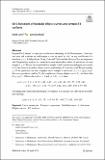| dc.description.abstract | Abstract
Inspired by Lehmer’s conjecture on the non-vanishing of the Ramanujan
$$\tau $$
τ
-function, one may ask whether an odd integer
$$\alpha $$
α
can be equal to
$$\tau (n)$$
τ
(
n
)
or any coefficient of a newform f(z). Balakrishnan, Craig, Ono and Tsai used the theory of Lucas sequences and Diophantine analysis to characterize non-admissible values of newforms of even weight
$$k\ge 4$$
k
≥
4
. We use these methods for weight 2 and 3 newforms and apply our results to L-functions of modular elliptic curves and certain K3 surfaces with Picard number
$$\ge 19$$
≥
19
. In particular, for the complete list of weight 3 newforms
$$f_\lambda (z)=\sum a_\lambda (n)q^n$$
f
λ
(
z
)
=
∑
a
λ
(
n
)
q
n
that are
$$\eta $$
η
-products, and for
$$N_\lambda $$
N
λ
the conductor of some elliptic curve
$$E_\lambda $$
E
λ
, we show that if
$$|a_\lambda (n)|<100$$
|
a
λ
(
n
)
|
<
100
is odd with
$$n>1$$
n
>
1
and
$$(n,2N_\lambda )=1$$
(
n
,
2
N
λ
)
=
1
, then
$$\begin{aligned} a_\lambda (n) \in&\{-5,9,\pm 11,25, \pm 41, \pm 43, -45,\pm 47,49, \pm 53,55, \pm 59, \pm 61,\\&\pm 67, -69,\pm 71,\pm 73,75, \pm 79,\pm 81, \pm 83, \pm 89,\pm 93 \pm 97, 99\}. \end{aligned}$$
a
λ
(
n
)
∈
{
-
5
,
9
,
±
11
,
25
,
±
41
,
±
43
,
-
45
,
±
47
,
49
,
±
53
,
55
,
±
59
,
±
61
,
±
67
,
-
69
,
±
71
,
±
73
,
75
,
±
79
,
±
81
,
±
83
,
±
89
,
±
93
±
97
,
99
}
.
Assuming the Generalized Riemann Hypothesis, we can rule out a few more possibilities leaving
$$\begin{aligned} a_\lambda (n) \in \{-5,9,\pm 11,25,-45,49,55,-69,75,\pm 81,\pm 93, 99\}. \end{aligned}$$
a
λ
(
n
)
∈
{
-
5
,
9
,
±
11
,
25
,
-
45
,
49
,
55
,
-
69
,
75
,
±
81
,
±
93
,
99
}
. | en_US |
